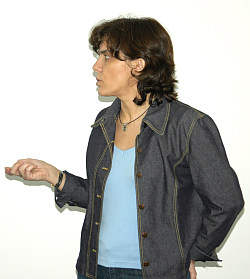 Prof Montserrat Zamorano from the University of Granada, School of Engineering, gave a lecture at Ashurst Lodge on “Energy Production from Agricultural Waste”, an important problem in the region of Granada, where there is a substantial amount of agricultural waste, including leftovers from the production of olive oil, an industry of paramount importance in the region and on the whole of Andalucia.
Prof Montserrat Zamorano from the University of Granada, School of Engineering, gave a lecture at Ashurst Lodge on “Energy Production from Agricultural Waste”, an important problem in the region of Granada, where there is a substantial amount of agricultural waste, including leftovers from the production of olive oil, an industry of paramount importance in the region and on the whole of Andalucia.
The Spanish Ministry of Science and Innovation supports a project run by Montserrat on Optimisation of the Production and logistics of pellets made from Agricultural Waste for domestic and industrial thermal applications. The project is also supported by the Innovation and Science Division of the Andalucia Government.
A pellet is produced from biomass originally of density varying from 40-200 kg/m3. The density of the resulting pellets is higher than 1,000kg/ m3.
The manufacturing process involves collection and chipping, drying, milling, pelletisation, plus storage and distribution.
The running plant in Granada produces pellets of 6mm diameter but this can be varied at will.
The use of these pellets is favoured because
- It is an abundant resource
- It is renewable
- Its application reduces CO2
- Avoids the use of imported fuels
It is also an important way to reduce waste and stop the uncontrolled combustion of agricultural waste, which has the added disadvantage of increasing the rate of forest fires.
It is important to optimise the location of the pellet plants in regions with sufficient agricultural waste and from where the resulting product can be distributed to the right users.
The process of combustion should be investigated in function of pellet size, materials, production processes, uses, etc.
The European Standards Committee has developed an experimental technical specification for solid biofuels and analytical technique (CETC 335). There are at present different standards in other countries, including some in Europe.
The pellets considered in the study were of 6-10mm diameter and 10-30mm long. Their heat value was 4.7-5 kcal/kg with a moisture content of 7-12% and ash content of less than 1%. Their bulk diversity was 650-700 kg/m3 and the pellet density less than 1,200kg/m3. The EU aims for ash control of less than 0.7% and no more than 0.07% of sulphur.
Poor quality pellets can produce slagging of boilers or higher ash content. They can result in poor burning behaviour.
The project also considered the capacity of pellet production in the Granada region, specially for olive trees. The production is 2,500 kg of waste per year and per hectare. Considering a total for Spain of 1,200,000 Ha, this results in 3 million tons of waste per year only from olive trees.
The cost/benefit analysis, life cycle assessment (LCA) and optimisation of the system’s logistics, as well as the environmental impact of the pellets are important considerations in the project.
The whole project will aim to optimise the production from the point of view of providing quality products and optimisation of the distribution of the project. The success of the project rests on the continuous satisfaction of the customer!

 Wessex Institute
Wessex Institute